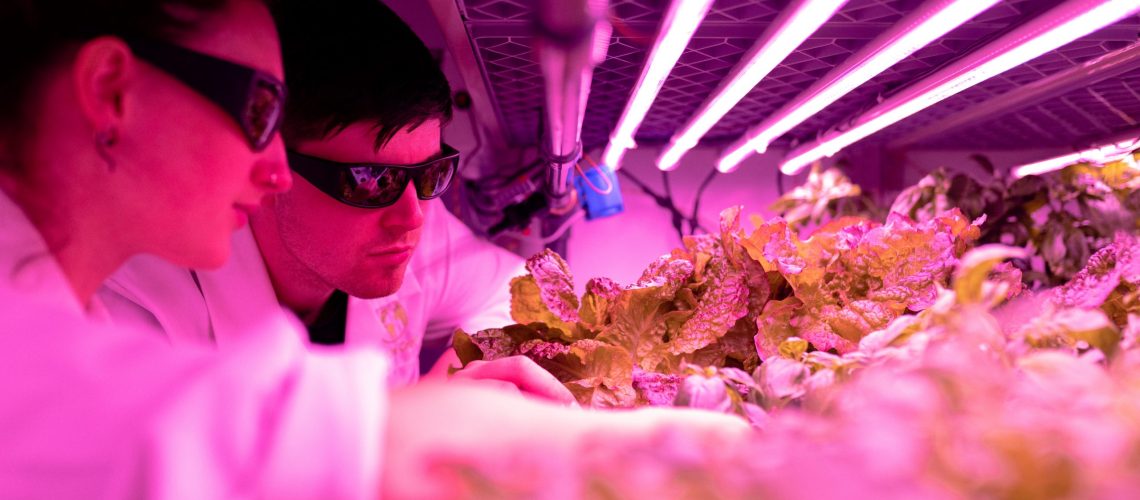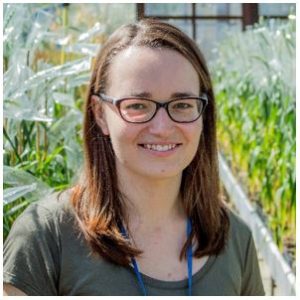

Jemima Brinton
MECEA 2017 Laureate
Weighing up a career in plant science
- Post-doc/Industry MECEA Winner 2017
- | Part of MECEA
My overriding memory of learning about plant science in school is weighing hundreds of dried peas which at 16, I didn’t find particularly thrilling. As a result, when I started university, I thought I was mostly interested in human biology and pathology. I’ll admit this was also partially motivated by an obsession with forensics programmes such as Silent Witness and CSI. Fortunately, my undergraduate course, Natural Sciences, was extremely broad and introduced me to a huge range of topics that I wouldn’t have chosen otherwise, including a fascinating course on plant science. This refocussed my interests completely and I went on to specialise in Plant Sciences, undertaking a summer project on starch metabolism and a final year research project investigating the potential roles of specific genes in C4 photosynthesis.
After finishing my undergraduate degree, I was offered a place on the Rotation PhD programme at the John Innes Centre (JIC) in Norwich. This PhD programme is slightly different from the more traditional PhD programmes in the UK in that you don’t begin your PhD with a set project. Instead, on arrival at the JIC, you choose three 10-week rotations projects in different labs and then usually choose one of these labs/projects (or a combination of two or three) to continue with for the remainder of your four years. Like my undergraduate course, the rotation programme exposed me to areas of research that I probably wouldn’t have considered before. In addition, the programme allows you to experience different lab environments and research approaches before embarking on your full project, which is a really unique and invaluable opportunity. Based on my previous experience, I thought I was likely to choose a project focussed on metabolism or biochemistry, and probably in a model species. Indeed, two of my rotation projects involved Arabidopsis. One looked at the mechanism by which plants regulate starch degradation and synthesis during day/night cycles and the other aimed to understand the relationship between proton pumping in the vacuole and nitrogen use efficiency. However, my third project was quite different and involved understanding the genetic basis of final grain yield in wheat. I really liked the fact that this project posed interesting and challenging scientific questions whilst also having a tangible application with respect to food security. Also, I found the pace at which wheat genomics and genetics resources were changing and developing really exciting. As such, I chose to continue with this project and my PhD has since focussed on understanding the mechanisms controlling grain weight in wheat with a view to increasing final yield.
 Gold coated grains ready for scanning electron microscopy to determine cell size
Gold coated grains ready for scanning electron microscopy to determine cell size
My PhD has been based around the hypothesis that breaking down complex traits, such as grain weight and yield, into their component parts and understanding the traits on different levels will allow us to manipulate them in a more informed and targeted manner. Before the start of my PhD, two wheat grain weight QTL had been identified on chromosomes 5A and 6A, the effects of which can be broken down into specific effects on grain length (5A QTL)1 and grain width (6A QTL)2. During my PhD, I have found that the 5A grain length QTL acts during early-mid grain development and the grain length increase can be broken down further to an effect on cell expansion in the seed coat/pericarp. Conversely, the 6A grain width QTL is likely to affect cell number in the grain since it acts very early during grain development, when most growth is occurring through cell division rather than cell expansion. To try and identify the genes underlying these QTL, I have used genetic mapping to reduce the QTL regions to progressively narrower genetic and, thanks to the release of multiple wheat genome sequences3-5, physical intervals. However, due to the large size of the wheat genome, our narrow intervals correspond to roughly two-thirds of the size of the entire Arabidopsis genome and contain hundreds of genes, making it difficult to prioritise candidates for further characterisation! To help narrow down these candidates I used RNA-seq to find genes that were behaving differently between lines with and without the QTL6. Now, by combining all the different layers of information we have about the QTL, we have been able to select a handful of candidate genes that we are currently testing using mutants fingers crossed!
 The 5A QTL specifically effects grain length
The 5A QTL specifically effects grain length
One of the things I have enjoyed most about my PhD is that it required me to use a wide variety of approaches and look at things from many different angles. From lab to microscope to field to computer, my PhD experience has been similar to my undergrad degree and rotation year in exposing me to things that I hadn’t previously experienced. In particular, the RNA-seq analysis required me to learn how to code, which was a very steep learning curve but by far one of the most rewarding experiences of my PhD so far and something I would recommend to anyone!
In many ways, I haven’t come so far from my school days: I have simply swapped weighing dried peas for weighing dried grains. My obsession with forensics lives on through listening to hours of true crime podcasts in the field and lab whilst doing the more tedious side of science. I’m not sure how impressed my 16-year-old self would be if I told her I’d be spending at least four years of my life weighing grains, but I’d tell her that if I’ve learnt anything over the last few years it’s to keep an open mind!
References
- 1: Brinton, J. et al. Increased pericarp cell length underlies a major quantitative trait locus for grain weight in hexaploid wheat. New Phytologist 215, 1026-1038, doi:10.1111/nph.14624 (2017).
- 2: Simmonds, J. et al. Identification and independent validation of a stable yield and thousand grain weight QTL on chromosome 6A of hexaploid wheat (Triticum aestivum L.). BMC Plant Biology 14, 191, doi:10.1186/s12870-014-0191-9 (2014).
- 3: IWGSC. A chromosome-based draft sequence of the hexaploid bread wheat (Triticum aestivum) genome. Science 345, 1251788, doi:10.1126/science.1251788 (2014).
- 4: Clavijo, B. J. et al. An improved assembly and annotation of the allohexaploid wheat genome identifies complete families of agronomic genes and provides genomic evidence for chromosomal translocations. Genome Research 27, 885-896, doi:10.1101/gr.217117.116 (2017).
- 5: Zimin, A. V. et al. The first near-complete assembly of the hexaploid bread wheat genome, Triticum aestivum. bioRxiv, doi:10.1101/159111(2017).
- 6: Brinton, J., Simmonds, J. & Uauy, C. Ubiquitin-related genes are differentially expressed in isogenic lines contrasting for pericarp cell size and grain weight in hexaploid wheat. BMC Plant Biology 18, 22, doi:10.1186/s12870-018-1241-5 (2018).
About Jemima Brinton:
Jemima is currently a research fellow at Royal Botanic Gardens, Kew, but previously worked at the John Innes Centre for 7 years as both a PhD student and a Post-Doc.
Links
